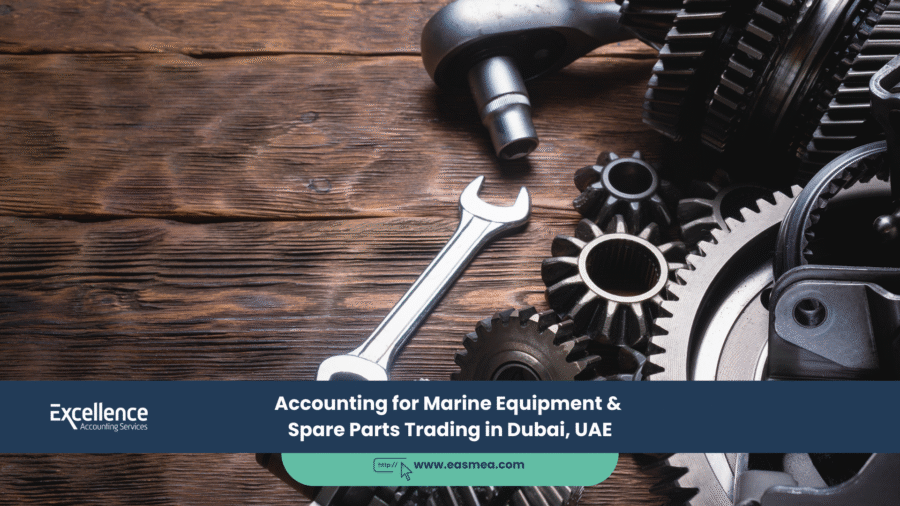Accounting for Marine Equipment & Spare Parts Trading in the UAE
The UAE’s strategic location has cemented its status as a global maritime hub, with ports like Jebel Ali serving as a critical crossroads for international shipping. This vibrant ecosystem supports a highly specialized and demanding industry: the trading of marine equipment and spare parts. Suppliers in this sector are the lifeline for vessels, providing everything from engine components and navigation systems to safety equipment and consumables.
- Accounting for Marine Equipment & Spare Parts Trading in the UAE
- Challenge 1: Navigating Multi-Currency Purchases
- Challenge 2: Mastering Diverse and High-Value Inventory
- Challenge 3: UAE Tax and Shipping Industry Nuances
- What Excellence Accounting Services (EAS) Can Offer
- Frequently Asked Questions (FAQs)
- Navigate Your Finances with Precision.
However, the accounting practices for this industry are as complex as the machinery they supply. Businesses must navigate a turbulent sea of multi-currency purchases from global manufacturers, manage a vast and diverse inventory for countless vessel types, and adhere to specific tax regulations governing the international shipping industry. Standard accounting practices are insufficient; success requires a specialized approach that addresses these unique challenges head-on.
This guide provides a comprehensive chart for navigating the financial complexities of marine equipment trading in the UAE. We will explore the correct accounting treatment for multi-currency transactions, strategies for complex inventory valuation, the nuances of VAT and Corporate Tax for the shipping sector, and how to build a resilient financial framework for your business.
Key Takeaways
- Master Multi-Currency (IAS 21): Purchases are often in USD, EUR, or JPY. You must record transactions at the spot rate and account for foreign exchange gains or losses on payment.
- Complex Inventory is the Norm: Inventory must be valued correctly (FIFO/Weighted Average) with strong provisions for obsolete parts for older vessels. The cost must include freight, duties, and clearance fees.
- Landed Cost is the True Cost: The value of your inventory isn’t the supplier’s price. It’s the “landed cost”—the total expense to get a part from the foreign factory to your UAE warehouse shelf.
- VAT is Not Simple: While the supply of goods to international-faring vessels may be zero-rated, the rules are strict. Incorrectly applying a zero rate can lead to significant penalties from the FTA.
- Profitability Depends on Control: Success hinges on tight control over forex exposure, accurate inventory costing, and efficient management of your accounts payable to global suppliers.
Challenge 1: Navigating Multi-Currency Purchases
Marine equipment is sourced globally. A single order book might contain purchases from Germany in Euros (€), Japan in Yen (¥), and Korea in Won (₩), while sales are often conducted in US Dollars ($), the de facto currency of the shipping industry. As a UAE business, your books are in AED. This creates constant foreign exchange exposure.
Under IAS 21, The Effects of Changes in Foreign Exchange Rates, the process is clear:
- Initial Recognition: When you receive an invoice from a supplier (e.g., for €10,000), you must record the purchase in AED using the exchange rate on the date of the invoice.
- Settlement: When you later pay that €10,000, the AED-EUR exchange rate will have changed. The difference between the AED amount you initially recorded and the AED amount you actually paid is recognized as a **foreign exchange gain or loss** in your profit and loss statement.
Example: You receive an invoice for €10,000 when the rate is 1 EUR = 4.00 AED. You record a payable of AED 40,000. A month later, you pay the bill when the rate is 1 EUR = 4.05 AED. Your bank debits you AED 40,500. The extra AED 500 is recorded as a “Foreign Exchange Loss.”
Effectively managing this requires diligent accounting and bookkeeping and can be supported by strategic CFO services to implement hedging strategies.
Challenge 2: Mastering Diverse and High-Value Inventory
A marine parts trader’s inventory is its biggest asset and its greatest challenge. You stock parts for different vessel types (bulk carriers, container ships, oil tankers), various engine makes, and multiple generations of technology. This complexity demands a robust inventory management and accounting system.
Key Inventory Accounting Policies:
- Valuation Method: You must choose a consistent method, either First-In, First-Out (FIFO) or Weighted Average Cost. FIFO is often preferred as it aligns the cost of older stock with the earliest sales.
- Landed Cost Calculation: The cost of inventory is not just the purchase price. It must include all costs to bring it to your warehouse: freight charges, insurance, import duties, and customs clearance fees. This “landed cost” is the true basis for your inventory valuation.
- Provision for Obsolete Stock: The maritime industry evolves. Parts for older vessel models may become slow-moving or obsolete. You must regularly review your inventory and create a provision to write down the value of this stock. An internal audit can help establish a formal review process for this.
| Inventory Challenge | Description | Accounting Solution |
|---|---|---|
| Diverse Stock | Thousands of SKUs for different engines, pumps, and navigation systems. | Use a sophisticated inventory management system integrated with your accounting software. Implement perpetual inventory tracking. |
| Determining Cost | A part costs €1,000, but shipping is €50 and duties are €55. | The inventory cost is not €1,000. It is the landed cost of €1,105 (converted to AED). |
| Obsolete Parts | Parts for a 20-year-old engine model that are no longer in demand. | Create a “Provision for Slow-Moving Inventory” to reduce its value on the balance sheet and recognize the expected loss. |
Challenge 3: UAE Tax and Shipping Industry Nuances
The tax treatment for the maritime sector has specific rules that must be followed carefully.
VAT Application
While most goods and services in the UAE are subject to 5% VAT, the supply of goods and services to the international shipping industry can be complex. The supply of goods for consumption or use aboard an international-faring vessel may be eligible for a **zero rate of VAT**. However, strict conditions and documentation requirements apply. Misinterpreting these rules and incorrectly zero-rating a supply can lead to severe penalties. Engaging expert VAT consultants is highly recommended to ensure compliance.
UAE Corporate Tax
Your trading business is subject to the 9% UAE Corporate Tax. Your meticulously calculated cost of goods sold (including landed costs and inventory provisions) and foreign exchange losses are deductible expenses that will reduce your taxable income. Maintaining pristine records is your best defence in a tax audit. Professional corporate tax services can ensure you are optimizing your tax position while remaining fully compliant.
What Excellence Accounting Services (EAS) Can Offer
The marine equipment trade demands a financial partner who understands its unique currents. EAS provides specialized accounting services to keep your business sailing smoothly.
- Multi-Currency Accounting: We manage complex payables and receivables in multiple currencies, ensuring accurate forex gain/loss reporting and compliant financial reports.
- Inventory Costing & Control: We help you implement systems to calculate accurate landed costs and manage inventory valuation, including setting up policies for obsolete stock provisions.
- VAT Advisory for Maritime: Our VAT experts provide clear guidance on the application of zero-rating for supplies to international vessels, ensuring you meet all FTA documentation requirements.
- Due Diligence Services: Looking to acquire a competitor or a new product line? Our due diligence services can assess the financial health and inventory quality of the target.
Frequently Asked Questions (FAQs)
Supplier rebates should be treated as a reduction in the cost of inventory. You should accrue for expected rebates throughout the year based on your purchase volume. When the credit note is received, it is credited against your Cost of Goods Sold or Inventory, effectively reducing the cost of the parts you purchased.
This depends on the shipping terms (Incoterms). If the terms are FOB (Free on Board) shipping point, the ownership and risk transfer to you the moment the goods are loaded onto the vessel. In this case, you must include the value of these goods in your year-end inventory, even though you haven’t physically received them.
Used parts should be valued at their “net realizable value” (NRV)—the estimated selling price less any costs to recondition and sell them. They should be clearly segregated from new inventory and valued conservatively.
Besides diligent accounting, you can use financial instruments like forward contracts to lock in an exchange rate for a future payment. This is a hedging strategy that can be explored as part of strategic CFO services.
No. Consignment stock legally belongs to the supplier until you sell it. It should not appear as inventory on your balance sheet. You only record the purchase and the corresponding payable at the point of sale to the end customer.
Generally, a specific provision for inventory obsolescence that is well-documented and based on a clear, consistently applied policy is a deductible expense for tax purposes. A general, unsubstantiated provision may be challenged by the tax authorities.
You need robust proof that the vessel is engaged in international transport and that the goods were delivered to and accepted by the vessel’s master. This typically includes the vessel’s registration documents, the delivery note signed by the master, and proof of the vessel’s voyage itinerary.
In a period of rising prices, FIFO results in a higher closing inventory value (as it’s valued at the most recent, higher costs) and a more accurately stated gross profit. It also often better reflects the physical flow of goods, as you typically sell your oldest stock first.
This surcharge is part of your revenue. It should be recorded as “Service Revenue” or “Urgent Delivery Fees” alongside the revenue from the sale of the goods. It is fully taxable for both VAT and Corporate Tax purposes.
Incoterms determine the exact point at which risk and ownership of goods transfer from the seller to the buyer. This is critical for revenue recognition (for your sales) and for recognizing inventory and payables (for your purchases). For example, under CIF (Cost, Insurance, and Freight) terms, you only take ownership when the goods arrive at the destination port, which affects the timing of your accounting entries.
Conclusion: Charting a Course for Profitability
The marine equipment and spare parts trading industry is a high-stakes, high-reward sector. Success demands more than just sourcing the right parts; it requires a sophisticated financial operation that can manage the immense pressures of global currencies, complex logistics, and specialized regulations.
By implementing a robust accounting framework that calculates true landed costs, manages foreign exchange risk, and ensures tax compliance, you can navigate the complexities of the market with confidence. This financial discipline is the anchor that secures your margins and sets your business on a course for long-term, sustainable profitability.
Navigate Your Finances with Precision.
Let Excellence Accounting Services be your financial first mate, managing the complexities of multi-currency accounting, inventory, and maritime tax compliance.




